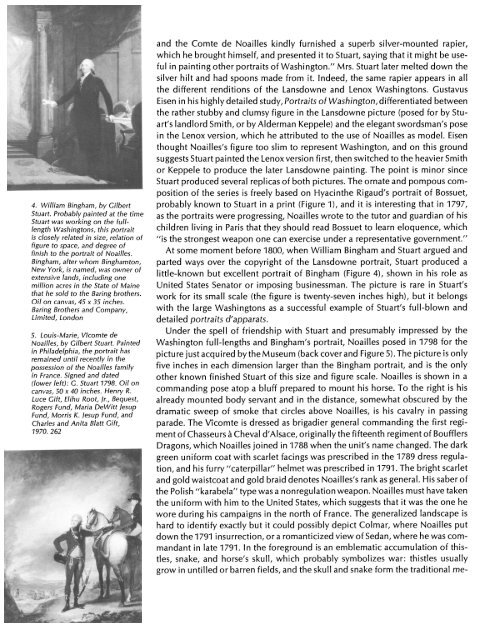The Metropolitan Museum of Art Bulletin, v. 29, no. 7 (March, 1971)
The Metropolitan Museum of Art Bulletin, v. 29, no. 7 (March, 1971)
The Metropolitan Museum of Art Bulletin, v. 29, no. 7 (March, 1971)
You also want an ePaper? Increase the reach of your titles
YUMPU automatically turns print PDFs into web optimized ePapers that Google loves.
4. William Bingham, by Gilbert<br />
Stuart. Probably painted at the time,<br />
Stuart was working on the fulllength<br />
Washingtons, this portrait<br />
is closely related in size, relation <strong>of</strong><br />
figure to space, and degree <strong>of</strong><br />
finish to the portrait <strong>of</strong> Noailles.<br />
Bingham, after whom Binghamton,<br />
New York, is named, was owner <strong>of</strong><br />
extensive lands, including one<br />
million acres in the State <strong>of</strong> Maine<br />
that he sold to the Baring brothers.<br />
Oil on canvas, 45 x 35 inches.<br />
Baring Brothers and Company,<br />
Limited, London<br />
5. Louis-Marie, Vicomte de<br />
Noailles, by Gilbert Stuart. Painted<br />
in Philadelphia, the portrait has<br />
remained until recently in the<br />
possession <strong>of</strong> the Noailles family<br />
in France. Signed and dated<br />
(lower left): G. Stuart 1798. Oil on<br />
canvas, 50 x 40 inches. Henry R.<br />
Luce Gift, Elihu Root, Jr., Bequest,<br />
Rogers Fund, Maria DeWitt Jesup<br />
Fund, Morris K. Jesup Fund, and<br />
Charles and Anita Blatt Gift,<br />
1970. 262<br />
and the Comte de Noailles kindly furnished a superb silver-mounted rapier,<br />
which he brought himself, and presented it to Stuart, saying that it might be useful<br />
in painting other portraits <strong>of</strong> Washington." Mrs. Stuart later melted down the<br />
silver hilt and had spoons made from it. Indeed, the same rapier appears in all<br />
the different renditions <strong>of</strong> the Lansdowne and Le<strong>no</strong>x Washingtons. Gustavus<br />
Eisen in his highly detailed study, Portraits <strong>of</strong> Washington, differentiated between<br />
the rather stubby and clumsy figure in the Lansdowne picture (posed for by Stuart's<br />
landlord Smith, or by Alderman Keppele) and the elegant swordsman's pose<br />
in the Le<strong>no</strong>x version, which he attributed to the use <strong>of</strong> Noailles as model. Eisen<br />
thought Noailles's figure too slim to represent Washington, and on this ground<br />
suggests Stuart painted the Le<strong>no</strong>x version first, then switched to the heavier Smith<br />
or Keppele to produce the later Lansdowne painting. <strong>The</strong> point is mi<strong>no</strong>r since<br />
Stuart produced several replicas <strong>of</strong> both pictures. <strong>The</strong> ornate and pompous composition<br />
<strong>of</strong> the series is freely based on Hyacinthe Rigaud's portrait <strong>of</strong> Bossuet,<br />
probably k<strong>no</strong>wn to Stuart in a print (Figure 1), and it is interesting that in 1797,<br />
as the portraits were progressing, Noailles wrote to the tutor and guardian <strong>of</strong> his<br />
children living in Paris that they should read Bossuet to learn eloquence, which<br />
"is the strongest weapon one can exercise under a representative government."<br />
At some moment before 1800, when William Bingham and Stuart argued and<br />
parted ways over the copyright <strong>of</strong> the Lansdowne portrait, Stuart produced a<br />
little-k<strong>no</strong>wn but excellent portrait <strong>of</strong> Bingham (Figure 4), shown in his role as<br />
United States Senator or imposing businessman. <strong>The</strong> picture is rare in Stuart's<br />
work for its small scale (the figure is twenty-seven inches high), but it belongs<br />
with the large Washingtons as a successful example <strong>of</strong> Stuart's full-blown and<br />
detailed portraits d'apparats.<br />
Under the spell <strong>of</strong> friendship with Stuart and presumably impressed by the<br />
Washington full-lengths and Bingham's portrait, Noailles posed in 1798 for the<br />
picture just acquired by the <strong>Museum</strong> (back cover and Figure 5). <strong>The</strong> picture is only<br />
five inches in each dimension larger than the Bingham portrait, and is the only<br />
other k<strong>no</strong>wn finished Stuart <strong>of</strong> this size and figure scale. Noailles is shown in a<br />
commanding pose atop a bluff prepared to mount his horse. To the right is his<br />
already mounted body servant and in the distance, somewhat obscured by the<br />
dramatic sweep <strong>of</strong> smoke that circles above Noailles, is his cavalry in passing<br />
parade. <strong>The</strong> Vicomte is dressed as brigadier general commanding the first regiment<br />
<strong>of</strong> Chasseurs a Cheval d'Alsace, originally the fifteenth regiment <strong>of</strong> Boufflers<br />
Dragons, which Noailles joined in 1788 when the unit's name changed. <strong>The</strong> dark<br />
green uniform coat with scarlet facings was prescribed in the 1789 dress regulation,<br />
and his furry "caterpillar" helmet was prescribed in 1791. <strong>The</strong> bright scarlet<br />
and gold waistcoat and gold braid de<strong>no</strong>tes Noailles's rank as general. His saber <strong>of</strong><br />
the Polish "karabela" type was a <strong>no</strong>nregulation weapon. Noailles must have taken<br />
the uniform with him to the United States, which suggests that it was the one he<br />
wore during his campaigns in the <strong>no</strong>rth <strong>of</strong> France. <strong>The</strong> generalized landscape is<br />
hard to identify exactly but it could possibly depict Colmar, where Noailles put<br />
down the 1791 insurrection, or a romanticized view <strong>of</strong> Sedan, where he was commandant<br />
in late 1791. In the foreground is an emblematic accumulation <strong>of</strong> thistles,<br />
snake, and horse's skull, which probably symbolizes war: thistles usually<br />
grow in untilled or barren fields, and the skull and snake form the traditional me-

















